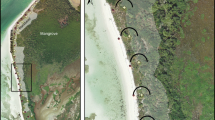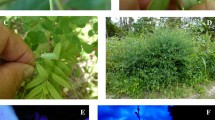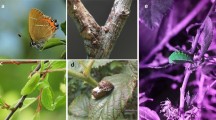Abstract
Monitoring of the Mission blue butterfly has been restricted to periodic counts of adults sighted during the flight season during transect walks. However, adult count data is a reliable index of population size only if the probability of detection is high and stable across varying ecological conditions. Determining these probabilities requires marking and capturing of a large number of individuals, which is harmful and difficult to implement for protected species. Therefore, we explored the potential of using immature stages (eggs, late-instar larvae and the feeding damage inflicted by larvae) as potential measures of population status for monitoring purposes. For each of these measures we examined its correlation with adult counts, its detection probability, and its repeatability. We found that immature stages and feeding damage are highly correlated with adult counts, are highly repeatable, and have detection probabilities that exceed estimates of the probability of detecting Mission blue adults. We conclude that late instar larval counts and foliar feeding damage are superior to adults as measures of population status for population monitoring. Furthermore, if sighting-resighting based counts of immatures or feeding damage are made on the same set of host plants on successive days, then estimates of abundance and its standard error adjusted for detection probabilities can be obtained.



Similar content being viewed by others
References
Arnold RA (1983) Ecological studies of six endangered butterflies (Lepidoptera, Lycaenidae): Island biogeography, patch dynamics, and the design of habitat preserves. University of California Berkeley Press, Berkeley
Asher J, Warren M, Fox R, Harding P, Jeffcoate G, Jeffcoate S (2001) The millennium atlas of butterflies in Britain and Ireland. Oxford University Press, Oxford
Augustin S, Guichard S, Svatos A, Gilbert M (2004) Monitoring the regional spread of the invasive leafminer Cameraria ohridella (Lepidoptera: Gracillariidae) by damage assessment and pheromone trapping. Environ Entomol 33:1584–1592
Bacca T, Lima ER, Picanco MC, Guedes RNC, Viana JHM (2006) Optimum spacing of pheromone traps for monitoring the coffee leaf miner Leucoptera coffeella. Entomol Exp et Appl 119:39–45
Barton BJ, Bach CE (2005) Habitat use by the federally endangered Mitchell’s Satyr Butterfly (Neonympha mitchellii mitchelii) in a Michigan prairie fen. Amer Midl Nat 153:41–47
Becker WA (1984) Manual of quantitative genetics, 4th edn. Academic Enterprises, WA
Bergh JC TC, Leskey TC (2003) Biology, ecology, and management of dogwood borer in eastern apple orchards. Can Entomol 135:615–635
Beyo J, Nibouche S, Goze E, Deguine JP (2004) Application of probability distribution to the sampling of cotton bollworms (Lepidoptera: Noctuidae) in Northern Cameroon. Crop Prot 23:1111–1117
Brakefield PM (1982) Ecological studies on the butterfly Maniola jurtina in Britain II: population dynamics: the present position. J Anim Ecol 51:727–738
Brown JA, Boyce M (1998) Line transect sampling of Karner blue butterflies (Lycaeides melissa samuelis). Environ Ecol Stat 5:81–91
Brown JJ, Kittelson NT, Hannon ER, Walsh DB (2006) An endemic population of western poplar clearwing moths (Lepidoptera: Sesiidae) invades a monoculture of hybrid poplar. J Econ Entomol 99:771–779
Castle SJ, Naranjo SE (2008) Comparison of sampling methods for determining relative densities of Homalodisca vitripennis (Hemiptera: Cicadellidae) on citrus. J Econ Entomol 101:226–235
Casula P (2006) Evaluating hypotheses about dispersal in a vulnerable butterfly. Ecol Res 21:263–270
Casula P, Nichols J (2003) Temporal variability of local abundance and activity in the Sardinian chalk hill blue butterfly. Oecologia 136:374–382
Collier N, Mackay DA, Benkendorff K (2008) Is relative abundance a good indicator of population size? Evidence from fragmented populations of a specialist butterfly (Lepidoptera: Lycaenidae). Popul Ecol 50:17–23
Coop LB, Croft BA, Drapek RJ (1993) Model of corn-earworm (Lepidoptera: Noctuidae) development, damage and crop loss in sweet corn. J Econ Entomol 86:906–916
Daterman GE, Wenz JM, Sheehan KA (2004) Early warning system for Douglas-fir tussock moth outbreaks in the western United States. West J Appl For 19:232–241
Dawson J, Hamilton AJ, Mansfield C (2006) Dispersion statistics and a sampling plan for Helicoverpa (Lepidoptera: Noctuiidae) on fresh-market tomatoes (Lycopersicon esculentum). Austral J Entomol 45:91–95
Dennis RLH, Sparks TH (2006) When is a habitat a habitat? Dramatic resource use changes under differing weather conditions for the butterfly Plebejus argus. Biol Conserv 129:291–301
Dennis RLH, Shreeve TG, Isaac NB, Roy DB, Hardy PB, Fox R, Asher J (2006) The effects of visual apparency on bias in butterfly recording and monitoring. Biol Conserv 128:486–492
Eichel S, Fartmann T (2008) Management of calcareous grassland for Nickel’s fritillary (Melitaea aurelia) has to consider habitat requirements of the immature stages, isolation and patch area. J Insect Conserv 12:677–688
Fleming TH, Serrano D, Nassar J (2005) Dynamics of a subtropical population of the zebra longwing butterfly Heliconius charithonia (Nymphalidae). Fla Entomol 88:169–179
Fred M, Brommer J (2003) Influence of habitat quality and patch size on occupancy in two populations of the Apollo butterfly (Parnassius apollo). J Insect Conserv 7:85–98
Fred M, O’Hara RB, Brommer J (2006) Consequences of the spatial configuration of resources for the distribution and dynamics of the endangered Parnassius apollo butterfly. Biol Conserv 130:183–192
Freese AJ, Benes R, Bolz O, Cizek M, Dolek A, Geyer P, Gros M, Knovicka A, Liegl Stettmer C (2006) Habitat use of the endangered butterfly Euphydryas maturna and forestry in Central Europe. Anim Conserv 9:388–397
Gross K, Kalendra EJ, Hudgens BR, Haddad NM (2007) Robustness and uncertainty in estimates of butterfly abundance from transect counts. Popul Ecol 49:191–200
Haddad NM, Hudgens B, Damiani C, Gross K, Kuefler D, Pollack K (2008) Determining optimal population monitoring for rare butterflies. Conserv Biol 22:929–940
Harker RJ, Shreeve TG (2008) How accurate are single site transect data for monitoring butterfly trends? Spatial and temporal issues identified in monitoring Lasiommatia megera. J Insect Conserv 12:125–133
Thomas Reid Environmental Sciences, Inc., (TRA) (2004) San Bruno Mountain habitat conservation plan, year 2003 activities report. Report to San Mateo County Parks Department, Menlo Park, CA
Knutson R, Kwilosz J, Grundel R (1999) Movement patterns and population characteristics of the Karner blue butterfly (Lycaeides melissa samuelis) at Indiana Dunes National Lakeshore. Nat Areas J 19:109–120
Krebs CJ (1999) Ecological methodology. Addison-Wesley-Longman, California
Lambert A (2002) 2002 Mission blue butterfly monitoring report—Milagra Ridge. Report to golden gate national parks association. Golden gate national recreation area, San Francisco, CA
Lessells CM, Boag PT (1987) Unrepeatable repeatabilities: a common mistake. Auk 104:116–120
Li SY, Fitzpatrick SM (1997) Monitoring oblique-banded leafroller (Lepidoptera: Tortricidae) larvae and adults on raspberries. Environ Entomol 26:170–177
Lindzey S (2004) 2004 Mission blue butterfly monitoring report—Milagra Ridge. Report to golden gate national parks conservancy. Golden gate national recreation area, San Francisco, CA
Lindzey S (2005) 2005 Mission blue butterfly monitoring report—Milagra Ridge. Report for golden gate national parks conservancy. Golden gate national recreation area, San Francisco, CA
Lindzey S (2006a) 2006 Mission blue butterfly monitoring report—Milagra Ridge. Report to golden gate national parks conservancy, San Francisco, CA
Lindzey S (2006b) 2006 Mission blue butterfly monitoring report—Oakwood Valley. Report for golden gate national parks conservancy, San Francisco, CA
Longcore T (2003) Analysis of butterfly survey data and methodology from San Bruno Mountain habitat conservation plan (1982–2000). University of Southern California GIS laboratory technical report no. 2, University of Southern California, Los Angeles
Longcore T, Lam C, Kobernus P, Polk E, Wilson J (2010) Extracting useful data from imperfect monitoring schemes: endangered butterflies at San Bruno Mountain, San Mateo County, California (1982–2000) and implications for habitat management. J Insect Conserv. doi: 10.1007/s10841-010-9263-9
Maes D, Vanreusel W, Talloen W, Van Dyck H (2004) Functional conservation units for the endangered Alcon blue butterfly Maculinea alcon in Belgium (Lepidoptera: Lycaenidae). Biol Conserv 120:229–241
Morton AC (1982) The effects of marking and capture on recapture frequencies of butterflies. Oecologia 53:105–110
Murphy DD (1987) Are we studying our endangered butterflies to death? J Res Lepidoptera 26:236–239
Murphy D, Weiss S (1988) A long term monitoring plan for a threatened butterfly. Conserv Biol 2:367–374
New TR (1993) The conservation biology of Lycaenidae. IUCN species survival commission. The World Conservation Union, Netherlands
Novotny J, Turcani M (1997) A new strategy for the ecological control of the gypsy moth (Lymantria dispar, Lepidoptera). Biologia 52:337–341
Nowicki P, Richter A, Glinka U, Holzschuh A, Toelke R, Henle K, Woyciechowski M, Settele J (2005) Less input same output: simplified approach for population size assessment in Lepidoptera. Popul Ecol 47:203–212
Pellet J, Fleishman E, Dobkin DS, Gander A, Murphy DD (2007) An empirical evaluation of the area and isolation paradigm of metapopulation dynamics. Biol Conserv 136:483–495
Petit S, Moilanen A, Hanski I, Baguette M (2001) Metapopulation dynamics of the bog fritillary butterfly: movement between patches. Oikos 92:491–500
Pham L, Boudreaux S, Karhbet S, Price B, Ackleh A, Carter J, Pal N (2007) Population estimates of Hyla cinerea (Schneider) (Green tree frog) in an urban environment. Southeast Nat 6:203–216
Pollard E (1977) A method for assessing change in the abundance of butterflies. Biol Conserv 12:115–132
Pollard E, Yates TJ (1993) Monitoring butterflies for ecology and conservation. Chapman & Hall, London
Pollock KH, Nichols JD, Simons TR, Farnsworth GL, Bailey LL, Sauer JR (2002) Large scale wildlife monitoring studies: statistical methods for design and analysis. Environmetrics 13:105–119
Pullin AS (1994) Ecology and conservation of butterflies. Chapman and Hall, New York
Rabasa S, Gutierrez D, Escudero A (2007) Metapopulation structure and habitat quality in modeling dispersal in the butterfly Iolana iolas. Oikos 116:793–806
Rashbrook V (2003) Survey of the endangered mission blue butterfly on the Marin Headlands, Spring 2003. Report to the golden gate national recreation area, San Francisco, CA
Rothery P, Roy DB (2001) Application of generalised additive models to butterfly transect count data. J Appl Stat 28:897–909
Royer R, Austin J, Newton L (1998) Checklist and “pollard walk” butterfly survey methods on public land. Amer Midl Nat 140:358–371
Scott JA (1986) The butterflies of North America. Stanford University Press, Stanford
Seidl A (1999) Population demographics and the conservation status of the uncompahgre fritillary Boloria acrocnema (Nymphalidae). J Lepidopterists Soc 53:32–36
Southwood TRE, Henderson PA (2000) Ecological methods. Blackwell Science, Oxford
Thomas Reid Environmental Sciences, Inc., (2005) San Bruno Mountain habitat conservation plan, year 2004 activities report. Report to San Mateo County Parks Department, Menlo Park, CA
Thomas Reid Environmental Sciences, Inc., (2007) San Bruno Mountain habitat management Plan, 2007. Report to San Mateo County Parks Department, Menlo Park, CA
Thomas JA, Simcox DJ (1982) A quick method for estimating larval populations of Melitaea cinxia L. during surveys. Biol Conserv 22:315–322
Van Strien AJ, Vandevert R, Moss D, Yates TJ, Van Swaay CAM, Vos P (1997) The statistical power of two butterfly monitoring schemes to detect trends. J Appl Ecol 34:817–828
Venette RC, Moon RD, Hutchison WR (2002) Strategies and statistics of sampling rare individuals. Ann Rev Entomol 47:143–174
Vozar A, Orvossy N, Kocsis M, Korosi A, Peregovits L (2005) First results of a study on Ceononypha oedippus in Hungary. In: Kuehn E et al (eds) Studies on the ecology and conservation of butterflies in Europe, Volume 1: general concepts and case studies. Pensoft-Sofia, Moscow, pp 22–28
Wang T (2004) Egg and larval ecology of the mission blue butterfly (Icaricia icarioides missionensis) on San Bruno Mountain. M.S. Thesis, San Francisco State University
Wilkstrom L, Milberg P, Bergman K (2009) Monitoring of butterflies in semi-natural grasslands: diurnal variation and weather effects. J Insect Conserv 13:203–211
Williams B, Nichols JD, Conroy M (2002) Analysis and management of animal populations: modeling estimation and decision making. Academic Press, San Diego
Yang X, Pal N (2009) Estimation of a population through capture-mark-recapture method: a comparison of various point and interval estimators. J Stat Comput Simul 80:335–354
Zheng C, Ovaskainen O, Saastamoinen M, Hanski I (2007) Age dependent survival analyzed with Bayesian models of mark-recapture data. Ecology 88:1970–1976
Acknowledgments
We would like to thank Sue Gardner and Christina Crooker at the Site Stewardship Program of the Golden Gate National Parks Conservancy and the wildlife ecologists of the Golden Gate National Recreation Area who offered support and assistance in pursuing this project. Research was conducted under the auspices of the monitoring program conducted annually by the Golden Gate National Parks Conservancy and the Golden Gate National Recreation Area in compliance with Fish and Wildlife Service regulations regarding ongoing habitat management and protection of the Mission blue butterfly; no individuals were handled or harmed as part of this research.
Author information
Authors and Affiliations
Corresponding author
Rights and permissions
About this article
Cite this article
Lindzey, S., Connor, E.F. Monitoring the mission blue butterfly using immature stages. J Insect Conserv 15, 765–773 (2011). https://doi.org/10.1007/s10841-010-9375-2
Received:
Accepted:
Published:
Issue Date:
DOI: https://doi.org/10.1007/s10841-010-9375-2




